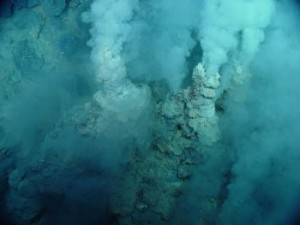
Image from the NOAA.
Now origin-of-life researchers face another huge problem – oxygen. You see, most evolutionists who accept scientifically irresponsible dating methods are confident of the fact that earth’s atmosphere didn’t have much oxygen in it until about 2.4 billion years ago. At that point, according to the evolutionary narrative, the evolution of photosynthesis allowed the carbon dioxide in earth’s ancient atmosphere to be converted into oxygen. This is called “The Great Oxidation Event,” and it is crucial to any evolutionary narrative.1
Why is this “Great Oxidation Event” crucial to evolution? Because all origin-of-life scenarios currently under consideration require earth’s atmosphere to be very low in or completely devoid of oxygen when life first evolved. A significant amount of oxygen would destroy any hopes of producing the molecules of life, as reactions with oxygen would convert them into chemicals that would not be useful in the chemistry of life.
We have known for a while that there is problem with evolution’s narrative about earth’s atmosphere. For example, Hiroshi Ohmoto and his colleagues produced a great review article on banded iron formations back in 2006.2 In that article, they show that these formations have been found in rocks that scientifically irresponsible dating methods show to be 3.8 billion years old. As they correctly point out, such formations (composed of bands of iron-oxide-rich rock and iron-oxide-poor rock) indicate a large amount of oxygen was present when they formed. Thus, they say that earth’s atmosphere (and ocean) had plenty of oxygen in it long before the supposed Great Oxidation Event.
Of course, evolutionists tend to be very resistant when it comes to giving up their narratives, so most see these formations as “enigmatic” and “mysterious.” Instead of accepting the clear implications of what these formations mean, they attempt to “explain around” their presence in order to preserve the idea that early earth’s atmosphere had very little or no oxygen in it until about 2.4 billion years ago. That, of course, allows them to cling to their desperate hope that life could be have formed naturally on the early earth.
Of course, as more data come in, this evolutionary narrative seems less and less credible. The latest blow comes from Masamichi Hoashi and his colleagues.3 In this study, they found hematite in rocks that scientifically irresponsible dating methods indicate are 3.46 billion years old. Hematite can be formed with or without oxygen, but in order to form it without oxygen, you need ultraviolet light. The problem is that the researchers use multiple lines of evidence to indicate that these rocks were formed in the ocean at depths greater than 200 meters. There is no ultraviolet light at those depths, so they conclude that the waters in which the hematite formed must have contained a lot of oxygen. As they say:
As our findings imply the existence of noticeable quantities of molecular oxygen, we propose that organisms capable of oxygenic photosynthesis evolved more than 700 million years earlier than previously recognized, resulting in the oxygenation of at least some intermediate and deep ocean regions.4
This produces a lot of problems for the evolutionary view. Remember, the standard formula used in evolution is:
mistakes + eons of time = what we see today
When evolutionists are faced with the amazing complexity of life, their typical response is to wave the magic wand in the above-listed formula – eons of time. “Sure,” they say, “life is complex, but given enough time for natural selection to work, all things are possible.” In other words, “With eons of time all things are possible.” This, of course, is hauntingly familiar to what Jesus said in Matthew 19:26, “…with God all things are possible.”
Hoashi’s study and the clear interpretation of banded iron formations strongly indicate that even if you believe the scientifically irresponsible dating techniques used, evolution’s magic wand has been shortened considerably. Now evolutionists must believe that life arose by chance and evolved into photosynthetic organisms in a mere 700 – 1,000 million years, instead of the 2,000 million years they used to give for this to happen. Will this deter evolutionists? I doubt it, because evolutionists have an enormous amount of faith in their god – “eons of time.”
REFERENCES
1. Canfiele, D.E., “The Early History of Atmospheric Oxygen: homage to Robert M. Garrels,” Ann. Rev. Earth and Planetary Sci, 33:1-36, 2005
Return to Text
2. Hiroshi Ohmoto, et. al., “Chemical and Biological Evolution of Early Earth: Constraints from Banded Iron Formations,” GSA Memoirs, 198:291-331, 2006
Return to Text
3. Masamichi Hoashi, et. al., “Primary Haematite Formation in an Oxygenated Sea 3.46 Billion Years Ago,” Nature Geoscience, 2:301 – 306, 2009
Return to Text
4. Ibid, p. 301
Return to Text

When will evolutionists actually become scientists and discard their theories?
Some scientists (like paleontologist Dr. Arlton C. Murray) already have. Some scientists (like Dr. Michael Denton) are at least partway there. Others, (like Dr. PZ Myers) never will.